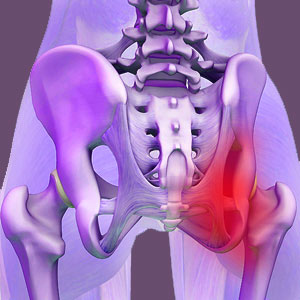
Acute piriformis pain can affect the muscle itself or much of the lower body anatomy, depending on the symptomatic mechanism. Acute presentations of piriformis syndrome often mirror the worst cases of sciatica, although in some cases, they can entail even more frightening symptoms, such as incontinence or sexual dysfunction. Injury, muscle balance and RSI might create acute pain locally in the soft tissues themselves, which are very different diagnoses from the above examples of nerve compression. Therefore, each acute presentation of piriformis pain must be evaluated as a unique entity in order to provide the best guidance on treating the symptoms.
Acute pain comes on quickly and severely, often at the least opportune times. Acute symptoms can force a patient off their feet and into bed to wait out the worst of the episode and can be very disruptive to living normally. When acute pain is recurrent or forms chronic patterns, patients have additional troubles, since they spend considerable time and energy managing their flare-ups, rather than concentrating on all of life’s other important responsibilities.
This focused essay delves into acute expressions of piriformis pain. We will investigate why pain might become acute and how it can be treated using a variety of techniques.
Acute Piriformis Pain Due to Sciatic Nerve Compression
Acute attacks of piriformis syndrome typically occur when the piriformis muscle clamps down on the sciatic and/or pudendal nerves. Some patients do not have regular pain on a daily basis, but do suffer acute episodes when the muscle spasms and constricts these vital neurological tissues. When the muscle does apply pressure to the nerve, acute pain is a common short-term result.
If the sciatic nerve is affected by compression, symptoms of pain, tingling, numbness and eventual weakness will occur in the legs and/or feet. If the pudendal nerve is targeted, then symptoms might appear in the perineum, pelvis, groin or genitals. In these cases, pain might be the least of the symptoms, since constipation, inability to urinate, fecal or urinary incontinence and sexual inability are all possible expressions.
Acute pain in either example often begins with discomfort at the site of compression and spread rapidly to innervated areas. Pain will usually only be mild to moderate, although some instances might entail more severe discomfort. Pain is also likely to fade over several days, being replaced by paresthesia and weakness in many patients.
Acute Pain in the Piriformis Muscle
Injury, RSI and muscular imbalances can enact symptoms within the piriformis muscle itself or in any of the surrounding soft tissues that are present in the great sacroiliac/hip/lower back/buttocks anatomy. Acute pain in the muscle here is usually mild to moderate, but might be severe in cases of extreme injury or dramatic imbalance leading to strain.
Injurious causation of acute pain will usually resolve organically, but some RSI and muscle imbalances may require professional intervention to cure. Luckily, both types of pain can usually be rectified using effective, conservative methods of care that do not require drugs or surgery. Most patients can be managed easily using exercises, stretches and various forms of constructive therapeutic interventions.
Acute Piriformis Pain Guidance
Acute symptomology can be terrifying when the pain is very severe. Even when the pain is moderate, symptoms can accumulate and make life a difficult burden until the agony resolves. Regardless of the diagnosis or cause, we provide some helpful guidance on avoiding worst fates when dealing with acute piriformis pain expressions:
Be wary of using pharmaceutical therapy for pain, unless absolutely necessary. Drugs are not constructive treatment and enact serious negative consequences in the body. Symptoms should be managed using natural and safe methods whenever possible, including heat, ice, massage, acupuncture, chiropractic or other constructive care regimen.
Beware surgical recommendations that often accompany recurrent acute flare-ups. Surgery is rarely indicated for piriformis pain conditions, nor is it known to be more effective than noninvasive treatment. In essence, if nonsurgical therapy fails many times, it is rare that surgical intervention will succeed. The problem n this scenario usually is found in the accuracy of the diagnosis, rather than the ineffectiveness of the treatments.
If pain is a major hurdle for you and you have difficulty managing symptoms time and time again, you might be an ideal candidate for pain coaching. This practice teaches clients life skills that can be applied to many health issues and is proven to be just as effectual as pharmacological pain management techniques, without any of the risks.
Ischemia is often the root source of pain as part of a mindbody syndrome. We see this often in cases of episodic piriformis syndrome where the patient suffers unpredictable outbreaks of nerve compression recurrently. This pattern often denotes a psychosomatic piriformis pain condition, although we also see plenty of cases of ongoing chronic symptomology caused by oxygen deprivation, as well.
Piriformis Pain >Piriformis Syndrome > Acute Piriformis Pain





